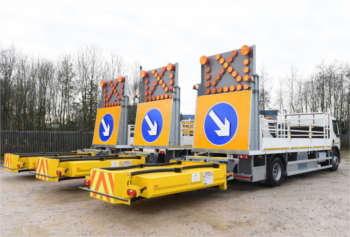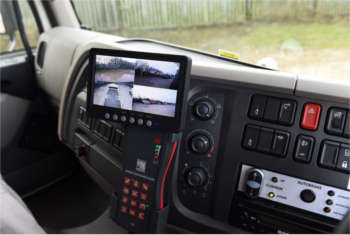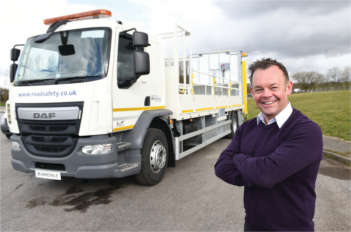Operator safety and public awareness of vehicles working on the road networks is vital. Richard Smith, joint managing director of Blakedale Limited, discusses how the public and private sectors are working to improve standards.
Any work activity involving the installation, maintenance and removal of temporary traffic management on the UK’s roads is potentially dangerous.
Local authorities and contractors can reduce the risks by using works vehicles that are designed to be highly visible to oncoming traffic.
Further protection can be achieved by deploying state-of-the-art Impact Protection Vehicles (IPVs), also known as Crash Cushions. These vehicles are equipped with illuminated light arrow signs at the rear, which are used to direct road users to the left or right of the vehicle.

Impact Protection Vehicles (IPVs)
This reduces the likelihood of a collision between a road user vehicle and a works vehicle, thus enabling workers to operate safely on foot in a coned off area.
In the event of a collision, IPVs are also designed to reduce injury severity to both road workers and road users by absorbing some of the impact energy.
The ripple effect
On the motorway network all works vehicles must adhere with the design and safety rules outlined by Highways England. For example, all works vehicles should be conspicuous in colour and equipped with work lights, high visibility chevrons, decals and body striping.
Additional guidance is provided by voluntary schemes such as FORS (Fleet Operator Recognition Scheme), as well as regional initiatives such as Transport for London’s (TFL) Construction Logistics and Cyclist Safety (CLOCS) programme.
Although not compulsory in all areas, the ripple effect of these regional initiatives means local authorities throughout the UK are increasingly likely to demand safer fleets that comply with the same or similar safety standards.
A visible advantage
Contractors can maintain a true competitive advantage by working in partnership with fleet suppliers who demonstrate a commitment to safety and innovation.
The latest safety devices, including side-scan CCTV cameras, driver audible alerts and vehicle manoeuvring warning alarms have been pioneered in TfL zones to improve driver visibility and reduce the risk of close proximity blind-spot collisions with cyclists and other vulnerable road users.
As a result of their continuing success, maintenance contracts all over the country are increasingly specifying that all works vehicles are equipped with this technology as a matter of best practice.

Multi camera cab mounted monitoring
All responsible suppliers should respond to this demand by incorporating these devices within all our vehicle specifications as standard.
Collaborating and evolving
A good fleet supplier will also place more emphasis on working collaboratively with road maintenance companies and their workers on evolving vehicle specifications to make their jobs easier and safer.
Our desire to make highway maintenance safer is rooted in our family’s history of working on high-speed roads. Having previously operated a motorway lighting installation company in the 1980s and 1990s, we have a personal understanding of the hazards road workers face on a daily basis. Today, we regularly visit our customers on site and seek their views on how we can further improve our vehicles to meet their needs.
It was partly due to this feedback that we decided to install a recordable, multi-camera system as standard to all our new 18 tonne IPVs, at no further cost to our customers. The system includes five infrared cameras that cover every angle of the vehicle, as well as live stream connection, vehicle tracking and telematics.
This provides high definition quality evidence of any accidents, incidents or near misses that occur around the vehicle or working areas. Real time streaming is already proving to be advantageous to the companies maintaining the networks.

Richard Smith joint MD of Blakedale Limited
Ahead of the game
In addition, operatives should look for suppliers who monitor and anticipate changes to industry standards as this enables them to develop compliant solutions before they are required.
A key safety target within the industry at present is to develop solutions that prevent road workers from crossing live carriageways on foot to erect temporary traffic management signs. For this purpose, the Interim Advice Note (IAN) 187/15, published October 2015, recommends the introduction of special Convoy Control Vehicles for working on dual carriageways.
Having closely followed the progress of the IAN 187/15, and as a result of our continuing investment, Blakedale will aim to be able to offer vehicles that meet this new standard, hence enabling substantial reductions in risks to road workers.
Works vehicles have evolved greatly in recent years, but as long as accidents still happen, even if their number is decreasing, contractors and local authorities should look for suppliers who strive to upgrade their fleets regularly so they can benefit from the investments that have been made to maximise safety.
Richard Smith is the joint managing director of Blakedale Limited - a family-run business that specialises in the hire and sale of Impact Protection and Traffic Management Vehicles.